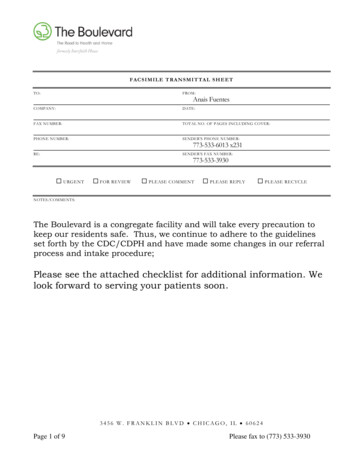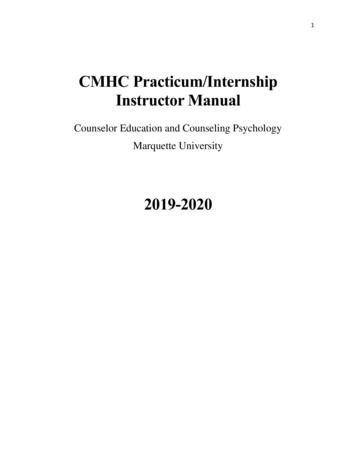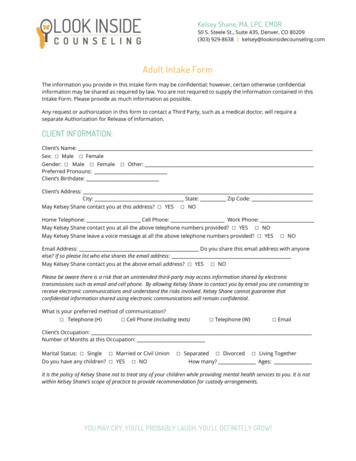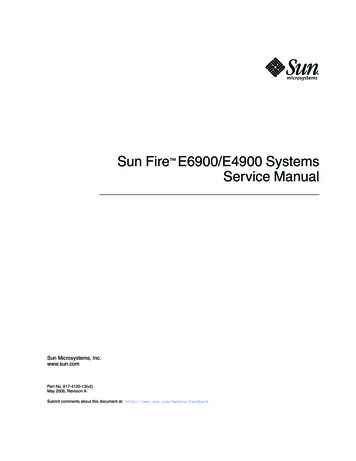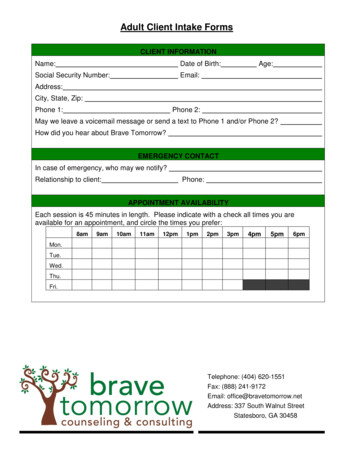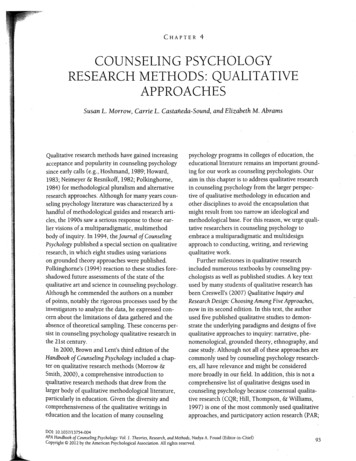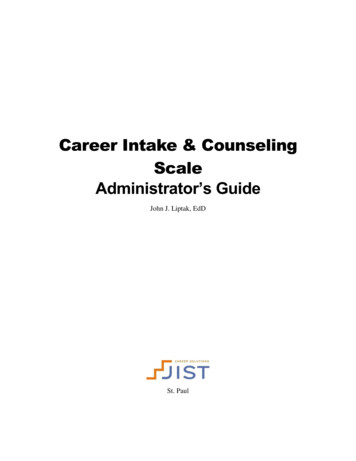
Transcription
Career Intake & CounselingScaleAdministrator’s GuideJohn J. Liptak, EdDSt. Paul
ContentsSummary and Background . 1Treatment Planning in Career Counseling . 1Treatment Planning Basics . 3Intake Assessment in Career Counseling . 4Need for the CICS . 6Administration and Interpretation . 7Steps of the CICS . 7Understanding and Interpreting CICS Scores . 8Scales Used on the CICS. 9I. Personal Barriers. 9II. Education and Training . 9III. Career Development . 9IV. Job Search . 9V. Job Transition. 10Illustrative Case Using the CICS . 10Research and Development. 11Guidelines for Development . 11Scale Development . 12Item Selection . 13Item Standardization . 14Reliability. 14Validity . 15References . 16About the Author . 18This booklet is designed to accompany the Career Intake & Counseling Scale (ISBN 978-1-63332-129-8). by JIST Publishing, Inc., 875 Montreal Way, St. Paul, MN 55102. Email: educate@emcp.com. Website:JIST.com. All rights reserved. Duplication of this document is permitted for internal distribution to staffusing the Career Intake & Counseling Scale (CICS). No other use is permitted without written permissionfrom the publisher. For additional career resources, please visit JIST.com. For a JIST catalog, call 800-3281452 or visit JIST.com.
Career Intake & CounselingScaleAdministrator’s GuideJohn J. Liptak, EdDThis brief guide was written to provide additional information for professionals using theCareer Intake & Counseling Scale (CICS). The CICS helps individuals identify their mainconcerns and the primary reasons for their lack of effective career development andsuccess. In addition, the CICS helps career and employment counselors gather intakeinformation that can aid them in conceptualizing their cases and developing effectivetreatment plans for their clients. It is designed to be self-scored and self-interpretedwithout the use of any other materials, thus providing immediate results for therespondent and/or counselor. It is appropriate for a wide variety of audiences, from highschool to adult.Summary and BackgroundAnyone seeking career assistance needs to have a comprehensive, detailed plan for howto proceed in order to further develop their career and attain long-term career success.Most often, career and employment counselors will simply ask clients what their needsare and how they can help. The problem with this approach is that most clients do notknow what they need in order to be more successful, and do not know how to go aboutsetting goals and working toward their goals. For career and employment counselors tobe more successful in developing a treatment plan for their clients, they need a structuredintake assessment that identifies client needs and concerns and provides a structured planfor treating their clients. The following sections will describe the treatment planningprocess in career counseling, provide treatment-planning basics, describe how an intakeassessment can be integrated into the treatment-planning process, and describe how theCICS was developed.Treatment Planning in Career CounselingTreatment planning is a process that has been talked about more in relation to careercounseling. While having a plan for the treatment of clients has always been seen as acritical component in mental health counseling, career counselors have begun to see thevalue of having a plan for helping their clients be more successful in developing longterm and short-term career goals. JIST Publishing, Inc.
According to the Diagnostic and Statistical Manual of Mental Disorders (AmericanPsychiatric Association, 2013), the intake interview, assessment, and development of atreatment plan are the first steps in effective counseling. Seligman (2004) added adefinition of treatment planning:Treatment planning is plotting out the counseling process so that bothcounselor and client have a road map that delineates how they willproceed from their point of origin (the client’s presenting concerns andunderlying difficulties) to their destination, alleviation of troubling anddysfunctional symptoms and patterns, and establishment of improvedcoping mechanisms and self-esteem (p. 161).Treatment plans can benefit both client and career counselor. Clients are served byhaving a written plan that details the specific issues that will become the focus of thecareer counseling sessions. Thus, career counselors will not lose track of the mostimportant issues and needs to be addressed for client success. Treatment plans also forcecareer counselors to think critically about the career counseling interventions that willbest help clients develop their career and be more successful. Liptak (2001) stated that“because a formalized plan is developed to guide the career counseling process, careercounselors are forced to stay on track and not stray from the client’s stated goals andobjectives” (pp. 18-19).Liptak (2001) suggested that career counseling should not be interested in a quick fix forclients. Rather it is an interpersonal process in which clients and career counselorsdevelop long-term plans for treatment. He said that “career counselors are often eager tosimply learn several career counseling theories and some techniques from each theory sothat they have a ‘quick fix’ solution to the clients’ problems” (p. 17) and that acomprehensive treatment plan needed to be developed on all clients based on theirdiagnosis.Bedi (2004) felt that as career counselors begin to see the interface of career counselingand personal, they need a system for planning the treatment of their clients. Liptak (2005)also felt the need for the systematic integration of personal counseling and careercounseling. He said that career counselors needed an intake system and a framework tobe able to successfully move back and forth between the two. Similarly, Peterson andGonzalez (2005) agreed that personal and career counseling “no longer need sharpdistinctions, because people who come for career counseling often require both, and thereverse is often true” (p. 270)Seligman (2004) suggested that treatment plans play many important roles in thecounseling process:1. They provide assurance that career counseling is likely to succeed2. They enable counselors to demonstrate accountability and effectiveness3. They specify goals and procedures to help counselors track progress, determine ifgoals are being met, and facilitate revision of the goals4. They provide structure and direction for the counseling processCareer Intake & Counseling ScaleAdministrator’s Guide JIST Publishing, Inc.Page 2
As you can see, the foundation of treatment plans in career counseling is gathering dataabout how clients’ career-related problems present themselves in the client’s life andcareer.Treatment Planning BasicsLiptak (2001) proposed that because the workplace is becoming much more complex,career counselor need to view their clients through a wide variety of perspectives, andtreatment plans are a key for plotting out the process of career counseling so that both theclient and counselor have a road map for how they will proceed. Liptak believes that “thefoundation of career counseling treatment plans is the data gathered regarding how theproblem presents itself in the client’s life” (p. 19). He suggested that there are six phasesin developing a treatment plan:Phase I: Intake Assessment – In effective career counseling sessions, clients are seen foran intake session before treatment begins. The focus of an intake is to “gather enoughinformation about the client to begin to formulate an effective treatment plan” (Liptak,2001, p. 19).Phase II: Case Conceptualization – In this phase, career counselors conceptualize themost significant problems identified in the Intake Phase. Career Counselors will work toidentify specific symptom patterns that will become the focus of treatment.Phase III: Goal Development – In this phase, career counselors and clientscollaboratively establish broad goals indicative of the client’s problems. These goalstatements are often expressed as global, long-term objectives that will guide thetreatment process.Phase IV: Constructing Objectives – In this phase, career counselors and clients constructspecific objectives that are stated in behaviorally measurable terms. Timetables forcompletion of the goal can help to keep counselors and clients on track.Phase V: Interventions – In this phase, career counselors identify specific actions thatneed to be taken to help clients achieve their goals and objectives. The actions should betied to the pattern symptom identified in the Intake Phase of the career counselingprocess.Phase VI: Evaluation and Termination – In this phase, career counselors evaluate theeffectiveness of the interventions being used in the treatment of specific client problems.Schwitzer and Rubin (2011) later said that a set of clinical thinking tools is required bywhich counselors “can describe a client’s functioning, gain an understanding of theperson’s situation and needs, identify goals for change, and decide on the most effectiveinterventions for reaching these goals” (p. 28). Their model consists of three componentsincluding:Career Intake & Counseling ScaleAdministrator’s Guide JIST Publishing, Inc.Page 3
Diagnosis, a tool for describing client needs – They suggested that counselor need a toolfor describing and categorizing client needs in a counseling situation. This tool should notreflect any specific theoretical orientation, but should help counselors across agencies tounderstand specific client needs.Case Conceptualization, a tool for understanding these needs – They suggested thatcounselors next need to be able to make sense of the client’s skills. Caseconceptualization skills include counselors being able to conceptualize a framework forworking with clients. Case conceptualization consists of three steps including: evaluationof client concerns through measurement, organization of this assessment informationbased on patterns and themes, and select a theoretical orientation and tools for meetingthe client’s needs. After the completion of case conceptualization, the counselor shouldhave a picture of what lead to the client concerns, what features are maintaining orperpetuating the problem, and what tools and techniques will best address, reduce,manage or resolve the clients’ issues.Treatment Plan, a tool for addressing these needs to bring about change. Oncecounselors have assessed and made their diagnosis and conceptualized the case, theyneed a coherent plan of action. Treatment plans are blueprints for the counseling processbased on the themes that need addressed. They conclude that basic treatment plans havefour steps including:o Behaviorally define the career counseling problems to be addressed as alist of the issues that will be the focus of counselingo Achievable goals are selected by prioritizing the client needs into ahierarchy of urgencyo Types of interventions are determined by taking into account the client’sparticular situation and dynamicso Explore how to know when changes have been measured and outcomesmet through such means as pre- and posttesting, observation, and clientreports (p. 33).Treatment plans in career counseling help the counselor and the client track their progressand determine the effectiveness in which goals are being met. They can help the clientknow how effective their career-counseling sessions are, and also to help careercounselors be more accountable. This model is being used as a framework in thedevelopment of the Career Intake & Counseling Scale.Intake Assessment in Career CounselingLiptak (2001) felt that the first and most important step in developing an effectivetreatment plan was an effective intake assessment. Similarly, America’s Career ResourceNetwork (2003) suggested that comprehensive career planning, based on client strengthsand needs, can lead to improved educational attainment and increased retention rates,higher levels of work satisfaction and career retention, and is positively linked to shorterperiods of unemployment. Zunker (2006) felt that identifying problems that can interferewith career choice and development are at the heart of most career intake interviews.Career Intake & Counseling ScaleAdministrator’s Guide JIST Publishing, Inc.Page 4
An intake can provide career counselors with valuable information about clients and theirprimary concerns and is usually a combination of an intake assessment and aconversation about the issues that bring each client in for career counseling. Careercounselors need to be able to make sound decisions so that their interventions fit throughthe appraisal of client needs and strengths. Capuzzi and Stauffer (2012) suggested that byusing objective and subjective methods of appraisal, career counselors “are better able todevelop plans that aid their clients in identifying problems and discovering effectiveproblem-solving strategies” (p. 417). Intake assessments in career counseling canpromote discussion about the goals and direction of the counseling sessions, andencourage independent thinking and reflection in clients.Intake assessments serve to categorize client concerns so that these concerns can be dealtwith effectively. Amundson (2003) said that the career intake process can be a messy onebecause most people come to counseling with problems that are not easy to categorize,but must be categorized. By categorizing career issues that are blocking client’s careerdevelopment, career counselors can develop a comprehensive plan for treating theirclients. Liptak (2001) suggested that intake assessments can assess the urgency of clientconcerns and allow career counselors to gather enough information to develop aneffective plan for treatment.Many career counselors utilize the intake assessment several times throughout the courseof career counseling. Gysbers, Heppner, and Johnston (2003) felt that career counselorsneed to be careful and conduct career intakes multiple times during their careercounseling sessions with clients. They suggested that “client presenting problems areonly a beginning point, and as counseling unfolds, other problems emerge” (p. 3). Zunker(2006) said that career counselors “are encouraged to expand the career counseling intaketo incorporate a more holistic approach when identifying client problems” (p. 149-150).He said that intake interviews assist clients in developing self-understanding, formingconclusions, identifying strengths and weaknesses, setting goals and identifyingalternative actions.Liptak (2001) concluded that an intake assessment is the first important step in theprocess of career counseling. He suggested that “in career counseling, accurateinterviewing and assessment are critical in diagnosing the client’s problem and indeveloping and implementing an effective treatment plan” (p. 29). Some of his thoughtsabout the purpose of intake assessments include: Intake assessments will probably take place in the first meeting with a client.Intake assessments will include a process that is much more than gatheringbackground information.The purpose of an intake assessment is to formulate a diagnosis and develop atreatment plan.Intake assessments help to determine whether clients can be treated or should bereferred to another agency.Intake assessments provide career counselors with an opportunity to explore theclient’s fears, motivation and commitment.Intake assessments help clients tell their unique story.Career Intake & Counseling ScaleAdministrator’s Guide JIST Publishing, Inc.Page 5
Intake assessments allow career counselors to know as much as possible abouttheir clients and the contexts in which their concerns occur.Career counselors must be responsible for helping their clients address issues of careersatisfaction and adjustment by initially identifying client desires, needs, competencies,and challenges (Capuzzi & Stauffer, 2012). Bezanson (2004) suggested that the termcollaborating professional replace the term counselor, and that the client andcollaborating professional co-construct a reality or framework that acts as a knowledgebase from which to begin developing a plan of action. As can be seen, the CICS can bevery beneficial as an intake assessment to help career and employment counselorsdevelop a conceptualization of their cases, develop goals to enhance the client’s careerdevelopment, and create an effective treatment plan. The next section will describe theneed for the CICS.Need for the CICSThe Career Intake and Counseling Scale (CICS) is designed to meet the need for a briefassessment instrument that acts as an intake for clients requesting career counselingservices. The CICS is based on the notion that as career development and careercounseling becomes more complex, there is an increasing need for tools to help careercounselors gather information about their clients, conceptualize client cases, and developan effective treatment plan for helping clients develop in their careers effectively. Liptak(2001) found that “a well-written treatment plan will clearly stipulate the client’spresenting problems and the intervention strategies that will facilitate the careercounseling process” (p. 19).Career counselors have increasingly seen the need to follow treatment plans in helpingtheir clients be more successful. As the use of treatment plans grows in working withclients who present career-related issues, so does the need for effective intakeassessments. Intake assessments allow career counselors to conceptualize their clientsmost significant and urgent problems. Liptak (2001) said that “each individual client willpresent his or her story in a unique manner with regard to how the problems presentthemselves” (p. 19).The CICS is designed to help career counselors to help their clients to explore their mosturgent presenting problems, identify specific symptom patterns, and focus treatmentbased on information gained from the intake assessment.The CICS is intended for use in any type of program that provides career counseling, jobsearch assistance, or vocational guidance including comprehensive career guidanceprograms, employment counseling programs, rehabilitation counseling programs, collegecounseling centers, college career centers, outplacement programs, prisons and paroleoriented programs, military transition programs, One Stop Centers, school-to-workprograms, welfare-to-work programs, and employee development programs.Career Intake & Counseling ScaleAdministrator’s Guide JIST Publishing, Inc.Page 6
Administration and InterpretationThe CICS has been designed for ease-of-use and can be administered electronically or inprint format. It can be easily scored and interpreted by the respondent. The assessmentconsists of 50 items that have been grouped into five scales that are representative of thethreats and barriers to career development identified in the literature. The printassessment includes scoring directions. (Scoring is done automatically on the electronic,web-based assessment.) Both print and electronic versions of the assessment includes aprofile and interpretation guide, a Suggestions for Attaining Career Success checklist,and a My Career Success Plan form.The CICS can be administered to individuals or to groups. It is written for individuals ator above the 7th grade level. Since none of the items are gender-specific, the CICS isappropriate for a variety of audiences and population.Steps of the CICSThe CICS is simple to take and can be easily scored and interpreted. Each assessmentcontains 50 statements that are related to client career concerns. Each statement asks testtakers to rate how well the statement describes their level of concern on a 3-point scaleranging from “A Major Concern” to “Not a Concern.” The CICS also includes scoringdirections, a scoring profile, descriptions of the five essential career intake areas, and aninterpretive guide that helps test takers to connect their results to strategies that can helpthem to overcome career barriers and concerns and a space is provided for test takers todevelop a career success plan. The CICS uses a series of steps to guide respondents. InStep 1, respondents are asked to circle the response that represents their answers for eachof the 50 statements. Respondents are asked to read each statement and circle theresponse that describes them based on the following Likert-scale choices:A Major ConcernSomewhat of a ConcernNot a ConcernEach of the scales is made up of 10 items that represent specific career concerns beingmeasured by the CICS.In Step 2 respondents add their scores for each color-coded scale. (In the electronic, webbased version, this step is done automatically for the test taker. The subsequent steps arethen renumbered.) Step 3 provides a chart which allows test takers to chart their scoresfrom 10 to 30. Results are recorded in the Intake Profile table. This Intake Profile tablehelps respondents to understand their scores better. Step 3 also helps test takers tointerpret what their scores mean by providing descriptions of the five scales. Step 4 helpstest takers explore activities for developing a long-term satisfying career by setting shortterm career goals. Step 5 encouragers test takers to develop a career success plan, andapply what they have learned to assist them in career and life transitions.Career Intake & Counseling ScaleAdministrator’s Guide JIST Publishing, Inc.Page 7
Understanding and Interpreting CICS ScoresThe CICS yields content-referenced scores in the form of raw scores. A raw score, in thiscase, is the total of the numbers circled for each of the ten self-report career concernstatements for the five scales. The performance of individual respondents or groups ofrespondents can only be evaluated in terms of the mean scores on each of the scales.Each respondent will get a score falling into one of the following three categories:Scores from 10 to 16 are low and indicate that clients need limited additional careercounseling and career planning in this area. This probably means that they feel they havethe skills and/or resources in this area to find and be successful in a job. The activities inStep 4 will help them to develop skills for meeting their most pressing career needs andconcerns.Scores from 17 to 23 are average and indicate that clients need some additional careercounseling and career planning in this area. This probably means that they feel they havesome of the skills and/or resources in this area to find and be successful in a job, but theycould use some additional career counseling. The activities in Step 4 will help them todevelop skills for meeting their most pressing career needs and concerns.Scores from 24 to 30 are high and indicate that clients need a great deal of additionalcareer counseling and career planning in this area. This probably means that they feelthey do not have many of the skills and/or resources in this area to find and be successfulin a job, and they could use career counseling. They should make every effort to acquirethe skills they need to be successful in this aspect of your career. They also need to seekout programs, professionals, and others who can help them. The activities in Step 4 willhelp them to develop skills for meeting their most pressing career needs.Respondents generally have one or two areas in which they score in the high or averagecategories. The respondents should concentrate on exploring their strengths andweaknesses first. However, they should also look for ways to use their scores to enhancetheir chances of personal and career success. This is best accomplished by havingrespondents complete all of the activities in Step 4. This will help them to think aboutimportant methods for overcoming personal concerns and barriers, identify educationaland training opportunities, developing a career, searching for a job, and transitioning intothe workforce.Keep in mind that it is not necessary to score high on every scale on the CICS. Thisassessment is designed to help people identify career deficiencies, barriers and needs thatmay be keeping them from being more successful in their professional lives and careers.Alternatively, some respondents may score in the average or low ranges for most or all ofthe five scales. If this is the case, the person may need to work very hard to develop thenecessary career goals and a plan for attaining the goals. For these people, it may bebeneficial to focus on strengthening one area, rather than trying to tackle all scales with alow-range score.Career Intake & Counseling ScaleAdministrator’s Guide JIST Publishing, Inc.Page 8
Scales Used on the CICSBecause the primary objective of this instrument is to help people identify the types ofcareer activities they need to address in order to reach long-term goals and attain careersuccess. The CICS is organized around five scales that represent major careerdeficiencies that keep people from being successful. These scales were chosen asrepresentative based on a literature review related to concerns and barriers people have indeveloping a career. They are as follows:I. Personal BarriersHigh scores on this scale indicate that it is important for you to get help in meeting yourbasic needs to be more employable. You may need help in finding a place to live whileyou are unemployed, being able to afford food for yourself and your family, buyingclothes for work, finding medical and dental care you can afford, making enough moneyto live on, and being able to afford a car or public transportation. You may need to learnmore about government agencies that can help you meet your basic needs and the needsof your family.II. Education and TrainingHigh scores on this scale indicate that it is important for you to get additional trainingand/or education in order to be more employable. You may need help in learning betterstudy skills, test-taking skills, or basic academic skills to succeed. You may need help infinding a way to finance additional educational opportunities. You may not know aboutavailable financial assistance, or you may not be aware of the costs of going back toschool. You may need help in overcoming certain social barriers to education such aspoor health, lack of partner/family support, living in an isolated area, or have mentaland/or physical disabilities that interfere with educational attainment. You may also haveto deal with family responsibilities that interfere with getting additional education.III. Career DevelopmentHigh scores on this scale indicate that it is important for you to learn more about thecareer development process in order to be more employable. You may not have defined aclear career path or started to look at yourself or potential careers. You may also notknow much about jobs that match your interests, skills, and personality. You may need toset career goals and identify ways to meet these career goals. You may also need somecounseling about career decision making and ways to implement your career goals.IV. Job SearchHigh scores on this scale indicate that it is important for you to plan and organize yourjob search in order to be more employable. You need help in the process of looking for ajob, learning more about how to network for employment, learning how to talk aboutyour experiences in employment interviews, exploring jobs of interest, and learning howCareer Intake & Counseling ScaleAdministrator’s Guide JIST Publishing, Inc.Page 9
to overcome gaps in your employment history. Your career counselor can also teachimportant job search skills such as writing a resume and cover letter, developing aportfolio, an
know how effective their career-counseling sessions are, and also to help career counselors be more accountable. This model is being used as a framework in the development of the Career Intake & Counseling Scale. Intake Assessment in Career Counseling Liptak (2001) felt that the first and most important step in developing an effective

